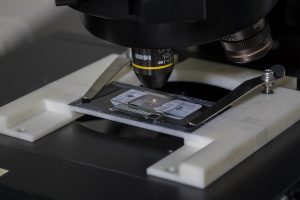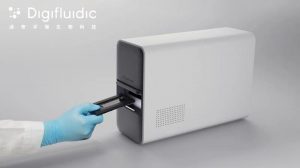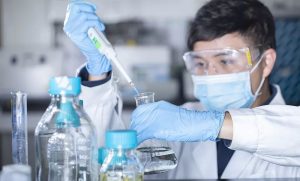The University of Macau (UM) is committed to fostering innovative sources for the sustainable development of the Macao Special Administrative Region, and promoting the transfer and application of research results, as well as the diversification of Macao’s economy. The number of patents owned by the university has increased nearly tenfold over the past decade, from 9 in 2011 to more than 90 in 2020. These patented technologies cover various fields, including biomedical sciences, traditional Chinese medicine, computer sciences, and microelectronics.
R&D in Cutting-edge Chip Technology
Chip research is one of the main research fields at UM. The State Key Laboratory of Analog and Mixed-Signal VLSI (AMS-VLSI Lab) at UM has achieved remarkable results, earning international recognition. It is now one of the most important silicon chip design and research centres at national and international levels. In addition to obtaining a number of patents in this field, the chip research team has also won a second prize of the State Science and Technology Progress Award in 2011. In 2019, UM was ranked second in the world in terms of the number of papers accepted by the International Solid-State Circuits Conference, next only to Intel. Virus Hunter, a virus detection system, developed by UM researchers with the university’s patented technology, can shorten the entire virus detection process to just 30 minutes.
Chinese Medical Sciences and Biomedical Sciences
The State Key Laboratory of Quality Research in Chinese Medicine at UM actively promotes scientific and technological innovation as well as commercialisation of research results, focusing on major key technologies related to the development of new Chinese medicines and quality assurance. Chinese medicine researchers at UM have obtained a number of patents and have won more than 100 awards, including a second prize of the State Science and Technology Progress Award, special science and technology awards in Macao, and gold awards at the International Exhibition of Inventions of Geneva. They have developed a microfluidic device for large-scale zebrafish screening, providing a new method for evaluating the efficacy of drugs using zebrafish models. They have discovered that Eucommia ulmoides contains special polysaccharide components that can ‘get along’ well with the growth factors in the human body that promote angiogenesis and maturation, and help regenerate damaged skin tissues. They have developed a new type of supramolecular nanovesicles loaded with high-potent herbicides, which may replace Paraquat, the most widely used pesticide in mainland China that is known to be detrimental to both human health and the environment. They have established an R&D platform for cancer drug resistance reversal agents based on autophagy regulation and have successfully identified a series of small-molecule autophagy regulators in traditional Chinese medicine that can address drug resistance issues in cancer treatment.
A research team in the Faculty of Health Sciences has developed a groundbreaking technology that enables storage of stem cells at room temperature for a minimum of seven days without the loss of viability and biological activities. This patented technology does not rely on the traditional cryopreservation method which requires costly equipment and tedious cryopreservation procedures, thus enabling cell storage and transport under ambient conditions. It has won numerous awards at regional and international entrepreneurship competitions and has even attracted considerable interest from potential investors.
Interdisciplinary Collaboration to Develop New Technologies
UM has made rapid progress in scientific research. In recent years, it has formulated a ‘3+3+3+3’ research blueprint. An interdisciplinary team formed by researchers in the Faculty of Health Sciences, Faculty of Science and Technology, and AMS-VLSI Lab, has developed droplet microfluidics for drug screening. Using advanced technologies in precision medicine, microfluidic chips, and image processing, the microfluidic technology can produce screening results within 24 hours. In addition, UM researchers also own a number of patents in the field of power and quality control devices.
Establishing a ‘5-in-1’ Technological Innovation and Transfer System to Support Industry-Academia Collaboration
UM provides strong support to industry-academic collaboration, and has established a ‘5-in-1’ technological innovation and transfer system.
First, UM adopts a problem-oriented approach, and gives priority to developing disciplines with local characteristics and in line with global trends. Essentially, the four 3’s in the ‘3+3+3+3’ research blueprint refer to UM’s three state key laboratories (for integrated circuits, Chinese medical sciences, and internet of things for smart cities, respectively ), three new key research areas (precision medicine for cancer treatment, advanced materials, and regional oceanography), three interdisciplinary research fields (artificial intelligence, cognitive and brain science, and data science), and three research platforms for humanities and social science (Centre for Macau Studies, Asia-Pacific Academy of Economics and Management, and Institute for Advanced Studies in Humanities and Social Sciences).
Second, UM has established the Research Services and Knowledge Transfer Office (RSKTO) to facilitate industry-academia collaboration, in order to improve the quality and efficiency of research-related services.
Third, UM has established a platform for managing industry-academia collaboration. The platform is mainly responsible for the following tasks: formulating regulations for intellectual property management and guidelines for patent assessment application; improving the procedures for patent application and technology transfer; formulating relevant policies and guidelines; and enhancing the quality and efficiency of intellectual property protection and knowledge transfer. At the same time, the university has restructured its wholly-owned subsidiary UMTec, which is mainly responsible for the management and industrialisation of UM’s intellectual property. The university has exclusively licensed a number of patents to UMTEC, which can then sublicense these patents to other companies.
Fourth, UM has established the Centre for Innovation and Entrepreneurship to nurture innovative talent. The centre has obtained approval from the Ministry of Science and Technology to serve as a national co-working space. The university has also launched a UM Macao Talent Programme to provide intellectual support for sustainable industry-academic collaboration.
Fifth, UM has established a platform for industry-academia collaboration in Hengqin to promote collaboration in the Greater Bay Area. The platform consists of five major R&D centres and advanced training centres, in such fields as microelectronics, Chinese medicine, smart city technology, translational medicine, and advanced materials. A joint laboratory has been established with Huafa Group to expand collaboration with industry.
Source: Communications Office
Media Contact Information:Communications Office, University of Macau
Albee Lei Tel:(853) 88228004Judite Lam Tel:(853) 88228022Email:prs.media@um.edu.moUM Website:www.um.edu.mo






